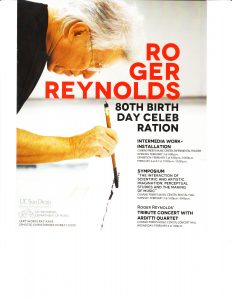Arditti Quartet’s Tribute to Roger Reynolds at 80
No one has exercised a more profound influence on the character and direction of music at UC San Diego than composer Roger Reynolds. So it was fitting that the university fete its Pulitzer Prize winning resident composer on his 80th birthday with a series of celebratory events culminating in a concert performed by the Arditti Quartet Wednesday (Feb. 4) in the Conrad Prebys Concert Hall.
Over the last three decades, Reynolds’ reciprocal relationship with Britain’s esteemed string quartet has proven ideal: he writes singular works for them, and they premiere and champion his music. Their program on Wednesday offered two of Reynolds’ more extended chamber works complemented by two shorter pieces by protégés Chaya Czernowin and Benjamin Hackbarth.
“not forgotten,” Reynolds’ recently completed (2010) string quartet might strike a first-time listener as a highly abstract work, yet it bristled with specific symbolism that bordered on the programmatic. Each of its six short segements embodies the composer’s memory of three composer colleagues—Toru Takemitsu, Iannis Xenakis, and Elliott Carter—and three geographic places—Monet’s Giverny garden, the Zen garden at Ryoanji Temple in Kyoto, and the Agean Sea.
Between each segment, a member of the quartet played an unaccompanied solo that deftly transitioned into the next segment. In addition to this clear structural alternation that gave the 30-minute quartet its satisfying shape, the Giverny module, a slow chorale of feathery, astringent glissandi, bookended “not forgotten.” Discrete, soft pizzicato notes, gentle taps on the body of each instrument and arid silences characterized the Japanese Zen garden, while the Carter segment began with chordal progressions that quickly built to a furious cadence, an homage to a climax in Carter’s Third String Quartet (gratefully pointed out in the composer’s program note). Takemitsu’s segment unfolded with predictably meticulous micro-progressions.
“Ariadne’s Thread,” Reynolds’ 1994 work for string quartet and UPIC-generated quadrophonic sound, embodied the composer’s passion for working with electronically generated sound and his ability to adroitly integrate this sonic resource into acoustic performance. One of Reynolds’ first feats after joining the UC San Diego music faculty in 1969 was to establish the Center for Music Experiment and Related Research, one of the pioneer electronic music studios in North America.
At the outset of “Ariadne’s Thread,” the string players fused their individual lines into Ariadne’s single thread—the one that helped Theseus escape from the Minotaur’s labyrinth—only to be confronted with the unfortunate complications of her rescue and escape with Theseus, embodied in the mighty electronic roar coming through the Conrad Prebys Concert Hall’s state of the art sound system.
Arditti gave Benjamin Hackworth’s “Liquid Study I” for string quartet and electronic sound a solid premiere performance. Like Reynolds’ allusion to the Zen garden in “not forgotten,” Hackworth opened his study with gentle taps on the body and strings of each instrument, then gradually transitioned into delicate bowed scrapes on the strings. Although the electronics initially appeared only to echo and decorate the acoustic sounds, they eventually overpowered the string players, only to quickly fade away. The composer was present to receive the audience’s accolades for his new work.
Czernowin’s severe, understated “Anea Crystal Cycle: Seed I” (2008) for string quartet evoked a muted conversation of stifled cries and whispers. “Seed I” is only the first movement of the larger piece, so perhaps it is a quiet prelude to more involved gestures.
At the end of the concert, Reynolds came to the stage to embrace each member of the Arditti Quartet—violinists Irvine Arditti and Ashot Sarkissjan, violist Ralf Ehlers, and cellist Lucas Fels—not only for the evening’s musical offering, but for many such elegant renderings of his demanding works.

Ken Herman, a classically trained pianist and organist, has covered music for the San Diego Union, the Los Angeles Times’ San Diego Edition, and for sandiego.com. He has won numerous awards, including first place for Live Performance and Opera Reviews in the 2017, the 2018, and the 2019 Excellence in Journalism Awards competition held by the San Diego Press Club. A Chicago native, he came to San Diego to pursue a graduate degree and stayed.Read more…


That’s a nicely detailed summary of a beautiful concert. Your descriptions of both the music and the extra-musical connections convey the experience of a special evening.
For exploring the art of music, San Diego is a very good place to be. That is thanks to many organizations, each of which brings something special. Here, I want to emphasize the fullness of UCSD’s offerings, as a valuable resource.
Between the institution itself and its donors, we’re seeing high levels of both visiting and resident talent, and the full gamut of programming from Renaissance vocals and Baroque harpsichord through to the most inventive contemporary works. It’s a fun, vibrant milieu that plays a unique role in the community and (as your review implies) influences the musical world.